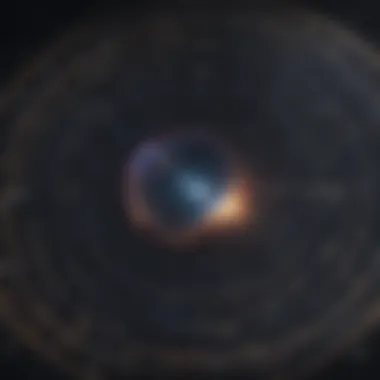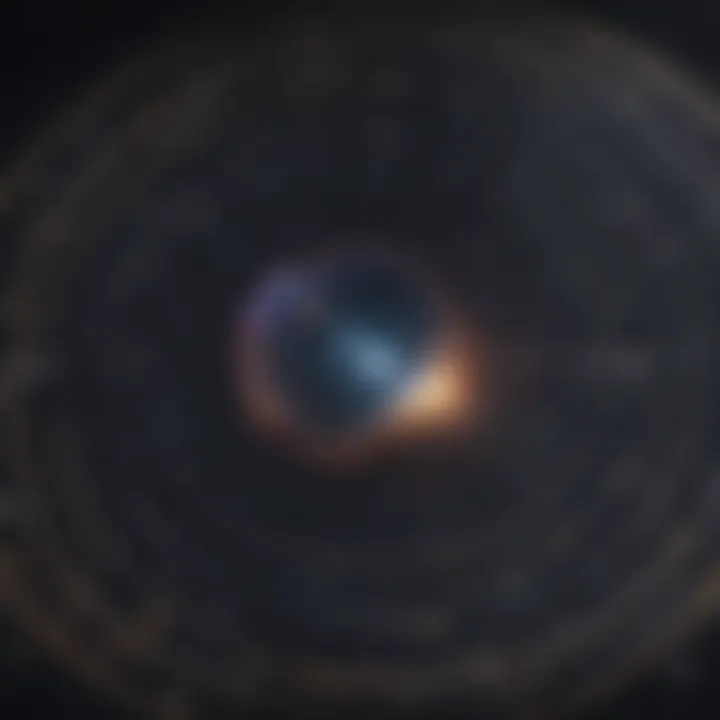Navigating the Night Sky: Your Guide to Star Charts


Intro
Star charts act as a guide to the night sky, revealing the hidden patterns among stars and celestial bodies. These charts have a rich history and practical applications in both astronomy and astrology. More than just tools for navigation, star charts help interpret celestial influences and provide insight into individual lives.
Understanding how to read and navigate these charts is crucial for anyone seeking to deepen their knowledge of the cosmos. This guide aims to equip enthusiasts—both beginners and experienced practitioners—with the necessary skills and insights to utilize star charts effectively. As we journey through this comprehensive exploration, we will cover the historical significance, modern uses, and practical applications of star charts in understanding celestial phenomena and astrological insights.
Understanding the Zodiac
The zodiac serves as a fundamental element in astrology. It comprises twelve distinct signs, each associated with specific traits, behaviors, and characteristics. This section delves into the intricate details of the Zodiac, highlighting its relevance in astrology.
Overview of Zodiac Signs
The twelve signs of the zodiac are Aries, Taurus, Gemini, Cancer, Leo, Virgo, Libra, Scorpio, Sagittarius, Capricorn, Aquarius, and Pisces. Each sign occupies a segment of the sky and the movement of celestial bodies through these signs is believed to influence individuals' personalities and life events.
Sign Traits and Characteristics
Every zodiac sign possesses unique traits. For instance:
- Aries: Bold and dynamic
- Taurus: Steadfast and reliable
- Gemini: Witty and adaptable
- Cancer: Nurturing and sensitive
Understanding these characteristics can assist individuals in recognizing their strengths and weaknesses through their astrological sign.
Elemental Qualities
Zodiac signs are also categorized into four elemental groups: Fire, Earth, Air, and Water. Each element imbues its signs with distinct qualities. Fire signs, for example, are passionate and energetic, while Earth signs focus on stability and practicality. Knowing one’s elemental quality can aid in comprehending how their sign interacts with others.
Astrological Insights
Astrology extends beyond mere sign identification and offers richer insights into cosmic phenomena. This section investigates current astrological trends and how celestial events influence daily life.
Current Astrological Trends
Astrologers closely monitor transits and events in the sky, such as retrogrades and eclipses. These movements can significantly impact emotional and physical states, providing opportunities for personal growth and understanding.
Influence of Celestial Events
Celestial events generate ripples in human behavior and emotions. For example, a full moon may heighten feelings, while Mercury retrograde could cause communication mishaps. Recognizing these influences allows individuals to prepare and navigate challenges with greater awareness.
How to Interpret Your Birth Chart
A birth chart, also known as a natal chart, provides an individualized view of the sky at the moment of one’s birth. It is crucial for understanding oneself and one's life path.
To interpret a birth chart, consider:
- Planetary positions
- Houses
- Aspects
Grasping these elements can reveal deeper insights into personal strengths and challenges, thus forging greater self-awareness through the lens of astrology.
Horoscope and Predictions
Horoscopes serve as distilled interpretations of astrological data, providing insights into the future. This section discusses how horoscopes are crafted and their implications for individuals.
Monthly or Weekly Forecasts
Many astrologers produce regular forecasts based on the movements of celestial bodies. These forecasts serve as guidance, helping individuals navigate potential challenges and opportunities in their lives.
Personalized Horoscope Reading
Personalized readings account for one’s unique birth chart, allowing for a nuanced understanding of astrological influences at play. This tailored approach can be more relevant than general horoscopes found in publications.
Compatibility Readings based on Zodiac signs
Understanding compatibility through zodiac signs can strengthen relationships. Certain signs tend to pair harmoniously, while others may clash. Knowing these dynamics provides valuable insight into interpersonal relationships.


By exploring the intricacies of star charts, zodiac signs, and horoscopes, individuals can find a deeper connection to the universe and themselves.
Understanding Star Charts
Star charts serve as navigational tools for individuals fascinated by the night sky. They offer clarity on how to identify celestial bodies, their positions, and movements. For astronomers and astrologers alike, understanding star charts is fundamental. It allows one to translate complex astronomical coordinates into practical information. This insight not only enhances astronomical knowledge but also supports personal insights within astrology.
Definition and Overview
A star chart is a graphical representation of the night sky at a specific time and location. It illustrates the positions of stars, planets, and other celestial objects. Typically, a star chart is oriented toward the observer's horizon and includes a grid system to denote celestial coordinates. The two primary coordinates used in star charts are right ascension and declination, similar to longitude and latitude on Earth.
Understanding star charts allows enthusiasts to locate constellations and other celestial phenomena with ease. They serve as valuable references for both stargazing and for deeper astrological studies. With accurate star charts, it becomes possible to track seasonal changes in the sky, study planetary movements, and explore constellations in detail.
Historical Context
The use of star charts dates back thousands of years. Ancient civilizations relied on them for agricultural, navigational, and spiritual purposes. For instance, the Babylonians created early celestial maps that helped predict astronomical events. Similarly, Greek astronomers, such as Ptolemy, published significant works containing extensive star charts that shaped our understanding of the cosmos.
In the Middle Ages, knowledge of star charts persisted in Islamic astronomy. Scholars preserved and expanded upon ancient knowledge, influencing the later European Renaissance. The shift from simple representations to more sophisticated models marked a significant leap in astronomical understanding. In modern times, technology has transformed star charts into intricate digital tools, yet their essence remains rooted in the practices of ancient astronomers.
Understanding the historical context of star charts deepens appreciation for their evolution. It signifies how civilizations used the stars not simply for navigation, but as guiding lights in their cultural narratives, philosophies, and sciences.
Components of a Star Chart
Understanding the components of a star chart is essential for anyone seeking to grasp the intricacies of astronomy and astrology. Each element within a star chart serves a specific purpose and contributes to a holistic understanding of the celestial sphere. The components we will discuss are crucial in interpreting the cosmos and the influences allegedly represented in astrological practices.
Celestial Sphere
The celestial sphere is the immense, imaginary sphere surrounding Earth onto which all celestial bodies appear to project. This concept is foundational in both astronomy and astrology. When you look at a star chart, you are essentially viewing a map of this sphere, depicting the positions of stars, planets, and other significant celestial markers at a given time and place.
Understanding the celestial sphere allows an individual to visualize the vastness of space beyond Earth. It forms the backdrop against which constellations, asterisms, and other celestial phenomena unfold. Importantly, the orientation of the celestial sphere plays a role in the principles of celestial navigation and the understanding of how various astronomical events can be observed from different geographic locations.
In practical terms, the celestial sphere can be divided into several key sections, such as the observer's local horizon, the zenith, and the nadir. This segmentation is vital in accurately interpreting star charts.
Constellations and Asterisms
Constellations and asterisms are familiar terms for many but offer much depth upon closer examination. Constellations are officially recognized patterns of stars that astronomers have cataloged and named. They serve as tools for navigation and understanding the night sky. Each constellation is associated with specific stars and can help in locating celestial objects.
On the other hand, asterisms are informal groups of stars. They are not defined by official boundaries but are often recognizable shapes or patterns formed by brighter stars. For example, the Big Dipper is an asterism within the constellation Ursa Major. Asterisms are particularly useful for amateur astronomers and stargazers, providing simpler patterns to identify.
Knowledge of constellations and asterisms enhances stargazing by adding context to the viewing experience. It provides a framework for deeper exploration of myths and stories associated with these shapes, fostering a greater connection to the night sky.
Zodiac Signs
Zodiac signs play a central role in astrology, providing a framework for interpreting celestial influences on human behavior and personality. The zodiac consists of twelve signs, each corresponding to specific celestial alignments along the ecliptic. Understanding zodiac signs requires an awareness that each sign spans roughly one month of the year, linking them with specific times and qualities.
Each zodiac sign is associated with elements and qualities, further enriching their interpretation. For example, Aries is a fire sign characterized by action and enthusiasm, while Cancer, a water sign, embodies emotion and intuition.
Astrologers rely on zodiac signs to construct personal horoscopes, offering insights into one’s personality traits and life events. Knowledge of the zodiac expands one’s understanding of the interplay between celestial movements and individual life experiences.
Astrological Houses
Astrological houses divide the celestial sphere into twelve sections, each representing different areas of life. Each house is linked to specific themes, such as identity, wealth, communication, and relationships. The precise position of planets within these houses at the time of one’s birth is believed to inform various aspects of their life journey.
Understanding astrological houses allows for a personalized interpretation of an individual’s birth chart. Houses shift depending on the time and place of birth, making each chart unique. For instance, if your natal Venus is in the seventh house, it may signify a strong focus on relationships and partnerships.
Astrological houses work in conjunction with zodiac signs, planets, and aspects, painting a detailed picture of personal experiences and tendencies. This comprehensive approach is what makes astrological interpretations rich and nuanced.
How to Read a Star Chart
Reading a star chart is a fundamental skill for anyone interested in astronomy or astrology. This process allows individuals to connect with the night sky and enhance their understanding of celestial events. Knowing how to read a star chart has practical benefits, especially for amateur astronomers and those keen on astrological practices. It provides insights into where to look for specific stars, planets, and constellations, as well as understanding one's astrological influences based on celestial positions at the time of their birth.
Basic Principles
To begin understanding how to read a star chart, there are several basic principles to keep in mind. First, familiarize yourself with the orientation of the chart. The top of the chart generally represents the north celestial pole, while the bottom represents the south. The left and right sides correlate to east and west, respectively. Moreover, star charts often display the ecliptic, a line that indicates the path the Sun appears to take through the sky over the year.


Another important concept is the scale of the chart. Some charts are designed for specific locations and times, so knowing your latitude and longitude can enhance accuracy. Star charts typically include a grid system. Each grid point corresponds to a particular celestial coordinate, making it easier to locate celestial objects.
Interpreting Symbols
Understanding symbols is crucial when reading a star chart. Symbols are often standardized, meaning that if you learn them once, you can apply that knowledge to any chart you encounter. Common symbols include points to represent stars, circles for planets, and lines for constellations. Additionally, different colors may denote various celestial bodies or areas of the chart. For instance, blue might indicate hot stars, while red can represent cooler ones.
Take time to refer to the legend of your star chart. This section clarifies the meaning of each symbol and its significance. As astrology incorporates a unique set of symbols, like houses and aspects, familiarizing yourself with these is essential for astrological interpretation as well.
Understanding Aspects
In astrology, aspects refer to the angles formed between planets and other celestial bodies in a chart. These angles hold significant interpretative value, as they suggest dynamics influencing an individual’s personality and life experiences. Key aspects include conjunctions, oppositions, trines, and squares, each carrying a different vibration that can drastically alter influence.
When analyzing your star chart or a natal chart, consider these aspects carefully. For example, a conjunction between Mars and Venus can indicate a strong relationship between assertiveness and love in a person's life. Understanding these relationships in the framework of your star chart can provide deeper insights into your astrological profile and guidance regarding personal growth.
Reading a star chart requires practice and study. However, once you grasp the basic principles, interpret symbols accurately, and understand aspects, you will enrich your exploration of the heavens. Each chart serves as a tool, enabling you to connect more intimately to the universe and your place within it.
Practical Applications of Star Charts
Star charts serve a pivotal role in both astronomy and astrology, providing valuable insights that extend beyond mere observation. Understanding their practical applications helps us appreciate their significance in our lives. This section will explore how star charts contribute to navigation and provide astrological insights.
Astronomy and Navigation
Star charts are essential tools for astronomers and navigators alike. They offer a visual representation of the celestial sphere, making it easier to locate stars, planets, and constellations. When navigating the night sky, star charts allow enthusiasts to track celestial movements, making them crucial for both amateur and professional astronomers.
A well-crafted star chart takes into account various celestial coordinates, such as right ascension and declination. This information enables accurate positioning of celestial bodies. Amateur astronomers can utilize these charts to plan their observations, identify potential viewing spots, and enhance their understanding of astronomical events.
In maritime navigation, celestial navigation remains a vital skill. Sailors have relied on stars for centuries to determine their position at sea. Using star charts, they can find important stars like Polaris, which indicates true north. By understanding the movement of stars and their relationships to one another, navigators can chart their course and enhance boat safety.
"Star charts not only connect us to the universe but also guide our travels across oceans."
Astrology and Personal Insights
In astrology, star charts function as essential templates for interpreting personal traits and life events. Each individual's birth chart contains the positions of celestial bodies at the time of their birth, reflecting unique insights into personality and destiny. Astrologers use these charts to provide tailored readings, offering guidance and predictions based on astrological principles.
Star charts play a significant role in synastry, a technique used to analyze relationship compatibility. By comparing the charts of two individuals, astrologers can uncover dynamics that may not be immediately apparent. This kind of analysis reveals how personal energies interact, helping individuals understand potential challenges and strengths in their relationships.
Moreover, the use of star charts extends into personalized astrological insights. Tracking transits—movements of planets through various signs—can help individuals understand when to expect change in their lives. Astrologers analyze these movements to offer predictions and advice.
In summary, the practical applications of star charts span a wide array of fields, including astronomy and astrology. Their utility enhances our understanding of the cosmos and improves personal insight through astrological interpretation. Star charts, thus, serve as powerful tools that connect us with the universe while providing a deeper understanding of our own lives.
Modern Tools for Star Chart Analysis
Modern tools for star chart analysis offer both enthusiasts and professionals a refined way to explore celestial mappings. Their significance lies in the ability to quickly access and interpret vast amounts of data from the stars and planets, enhancing user experience and understanding. These tools bring advancements over traditional methods, allowing for immediate feedback and a higher level of detail that can be crucial for accurate analysis.
Software and Apps
In recent years, various software and apps have emerged to assist users in star chart analysis. These tools often come with user-friendly interfaces and features designed to simplify the process of chart reading. For example, popular applications such as Stellarium and SkySafari provide rich visuals and allow users to simulate night sky experiences based on their location and time.
Key Benefits of Using Software and Apps:
- Interactive Features: Users can interact with a 3D model of the stars and planets, manipulating the view to understand their positions more clearly.
- Real-Time Updates: Many apps can track celestial phenomena as they happen, offering alerts for significant events like meteor showers or planetary alignments.
- Customizability: Users may customize settings for visibility, like latitude and longitude, and adjust for light pollution, improving accuracy in star sightings.
- Resource Availability: Integrated educational resources, such as articles and videos, help users grasp complex astronomical concepts.
In essence, these tools maximize the learning experience, making them essential for both beginners and experienced astrologers and tarologists.
Online Resources
The Internet offers a wealth of online resources that complement software and apps in star chart analysis. Websites such as Sky & Telescope and Heavens-Above provide detailed guides, articles, and tools that can enhance one's understanding of the night sky.
Considerations for Using Online Resources:
- Accuracy of Information: Always check the credibility of the sources used. Reliable websites provide accurate and updated data crucial for both astronomy and astrology.
- Community Engagement: Forums on platforms like Reddit host discussions around various star chart tools, offering user insights that can be invaluable for newcomers. Engaging with experienced users can foster learning and understanding beyond standard resources.
- Diverse Perspectives: Online blogs and articles often present unique interpretations and applications of star charts, enriching the users’ insights and knowledge.
In summary, the blend of software, apps, and online resources serves as a powerful toolkit for anyone looking to navigate the night sky effectively. They provide the necessary tools for interpretation and engagement with the universe, making star chart analysis an accessible and enriching experience.


The future of star chart analysis lies in combining advanced technology with traditional knowledge. This blend enhances accuracy and understanding, offering new avenues for analysis.
The Role of Star Charts in Spirituality
The significance of star charts in spirituality extends beyond mere maps of the night sky. They serve as tools for introspection and connection to larger cosmic forces. For those who engage with astrology, star charts become mirrors reflecting their innermost selves and guides for personal growth. Understanding this relationship adds depth to the study of both astronomy and spirituality. The concept of navigating the cosmos can invoke feelings of belonging and alignment with universal energies, enhancing one's spiritual journey.
Connecting with the Universe
Star charts facilitate a unique connection with the universe. By examining the positions of celestial bodies at specific times, individuals can chart their own paths and experiences. This connection is more than astrological; it touches upon a fundamental human desire to understand our place in the greater cosmos.
When observing the night sky through the lens of a star chart, practitioners can gain insights into their life circumstances and emotional states. Aspects in the chart provide a roadmap for self-discovery. Here, decoding planetary positions can reveal how external cosmic influences relate to personal challenges and aspirations.
- Understanding Energies: Each planet carries its own energy. For example, Saturn’s influence may relate to lessons and discipline, while Venus concerns love and relationships. Knowing these nuances helps individuals align their actions with the energies influencing them.
- Astrological Events: Transits and retrogrades marked on star charts signal important times for reflection and action. Observers can prepare for shifts in life paths by tracing these patterns.
Collectively, star charts offer a way to interpret universal energies, encouraging an open channel of communication with the cosmos.
Meditation and Reflection
Engaging with star charts can become a meditative practice. The act of studying one’s birth chart or current astrological transits can lead to enhanced awareness and reflection. By sitting in contemplation surrounded by physical charts or digital apps, individuals enter a space conducive to introspection.
- Mindfulness: Focusing on celestial patterns promotes presence. As individuals ponder the positions of stars and planets, they gain clarity about their lives and choices.
- Enhancing Intuition: Regular engagement with star charts may strengthen one’s intuitive abilities. Understanding the subtleties of astrological symbols helps refine instinctual responses to daily situations.
Furthermore, many practitioners incorporate star charts into their meditation sessions. By visualizing the constellations, it aids in deepening the connection to divine energies. Each session serves as not just a reflection on the self but also an alignment with the universe’s rhythm.
“Star charts tell tales of our existence, linking the finite to the infinite, inviting us to explore our spiritual landscape.”
Star Chart Interpretation in Astrology
Star chart interpretation in astrology is crucial to understanding an individual’s personality, potential, and relationship dynamics. These charts provide a unique snapshot of the heavens at the moment of one’s birth. By analyzing the positions of celestial bodies within these charts, astrologers can derive insights relevant to various aspects of life. This interpretation goes beyond simple sun sign readings; it unveils intricate details about one’s emotional landscape, ambitions, and spiritual inclinations.
Personal Birth Charts
Personal birth charts, often referred to as natal charts, represent the positions of the sun, moon, and planets at the time and place of a person's birth. Each celestial body symbolizes different facets of personality and behavior. For instance, the sun symbolizes one's core identity and ego, while the moon reflects one’s emotional nature.
Additionally, the planets occupy specific houses within the chart, each house representing a different area of life, such as relationships, career, and personal growth. While reading a birth chart, one must consider not only the signs and planetary placements but also the angles and aspects between these cosmic bodies. These dynamics can reveal potential strengths and challenges one may face throughout life.
Understanding your personal birth chart is like having a celestial roadmap that guides you through life’s journey.
Synastry and Compatibility Analysis
Synastry is the branch of astrology that assesses relationship compatibility by comparing the charts of two individuals. This practice reveals how their planetary positions interact, influencing their connection and mutual understanding. For example, if one person's Venus aligns favorably with another’s Mars, it can indicate strong romantic attraction and emotional harmony.
In synastry analysis, specific key factors come into play, such as:
- Planetary Aspects: These indicate how planets from one chart influence those in another.
- House Overlay: This shows how one partner’s planets fall into the houses of the other’s chart, revealing significant relational themes.
- Elemental and Modal Balance: Analyzing the balance of earth, water, fire, and air signs can inform about the couple's overall dynamic and compatibility.
A thorough synastry reading can provide deeper understanding and foresight regarding relationship challenges and strengths, guiding partners through their shared journey.
In summary, star chart interpretation in astrology, particularly through personal birth charts and synastry, offers profound insights into one’s life path and relational dynamics. Mastery in these areas empowers astrologers to guide individuals or couples considering their personal and shared destinies.
Future Perspectives on Star Charts
Understanding the future perspectives on star charts is essential, especially as we navigate a world increasingly intertwined with technology and evolving interpretations. This section highlights how advancements will influence both amateur and experienced users in astronomy and astrology. Star charts are not static; they adapt and grow with the enrichment of our collective knowledge.
Technological Advances
In recent years, technology has transformed how we interact with the night sky. Gone are the days of solely relying on printed charts. Today, sophisticated software and mobile applications bring the stars to our fingertips. Programs like Stellarium and SkySafari allow users to visualize the sky in real-time, providing interactive features that enhance learning and exploration.
This shift means increased accessibility. People can now explore constellations, planets, and celestial events from anywhere. Users can even receive notifications for significant astronomical events. Moreover, the integration of augmented reality is creating an immersive learning experience, where users can point their devices at the sky to identify celestial objects with ease.
However, as beneficial as technology is, it is crucial to maintain a balance. Relying solely on apps can lead to a superficial understanding of star charts. Engaging with physical maps can enhance one’s connection to the cosmos and deepen the appreciation for the manual study of stars and constellations.
Evolving Interpretations
The interpretations of star charts are continually evolving. Traditionally linked to astronomy and astrology, the future sees a broader application of these charts in various disciplines. For instance, interdisciplinary studies are emerging, merging astrology with psychology to explore personality traits based on celestial positions. This renewed interest influences how astrologers interpret charts, encouraging deeper personal insights.
Moreover, cultural shifts are prompting a re-examination of ancient star chart systems. Various cultures have unique interpretations of the night sky. As we become more global, there's potential for cross-cultural astrological practices to gain traction. By understanding different interpretations, practitioners can foster a richer dialogue about personal and collective experiences.
"Star charts are mirrors of our understanding, reflecting both historical and future perspectives of our place in the universe."
The future of star charts is bright, characterized by ongoing technological innovation and evolving interpretations. Both aspects promise to deepen our understanding of the cosmos and the insights we derive from it.







